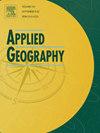The thermal environmental effects of changes in urban green space: A mesoscale modelling perspective
Abstract
Green space is an important adaptation strategy against urban thermal environmental change. However, the impact of the spatiotemporal changes in green space on urban mesoscale meteorology and human thermal comfort has been understudied. Here, we incorporated gridded urban green fraction (GF) corresponding to 2016 and 2020 in central Wuhan into the Weather Research and Forecasting model to investigate the thermal environmental effects of changes in GF. Results show that a 10% increase in GF produced a nighttime cooling of 0.167 °C and a daytime cooling of 0.075 °C. Meanwhile, it increased atmospheric moisture content by 0.131 g/kg in the daytime and 0.042 g/kg at night. Consequently, the nighttime heat index (HI) was reduced by 0.258 °C but the daytime HI was raised by 0.056 °C. Addition of GF induced a greater magnitude of change in 2-m air temperature and the HI when the GF in a grid cell exceeded 0.6. The reduction in ground heat flux due to the conversion of urban fraction to green fraction, in conjunction with the weak turbulence, contributed to the greater magnitude of cooling in the nighttime than in the daytime. To enhance green space connectivity should be an effective pathway to thermal adaptation in high-density built environments like Wuhan.

 求助内容:
求助内容: 应助结果提醒方式:
应助结果提醒方式:


